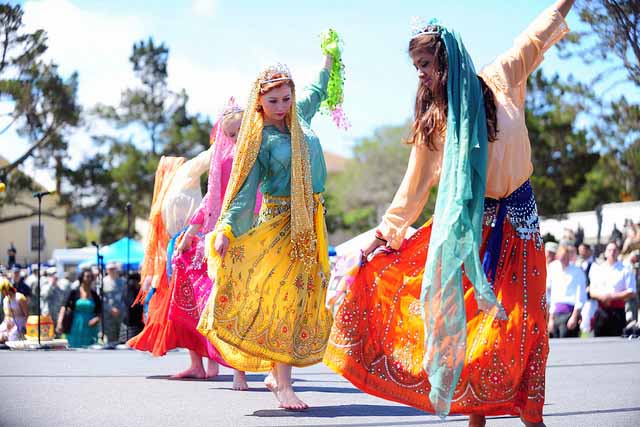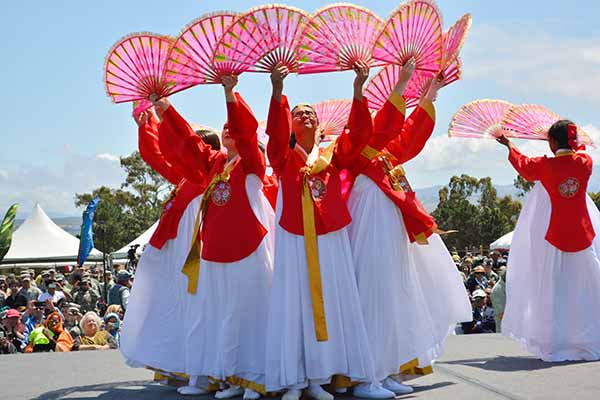Language Schools
All basic foreign language teaching takes place in the schools for undergraduate education. There are a total of six undergraduate education schools, some of which teach multiple languages. Additionally, there are half a dozen organizations and divisions which support the ongoing undergraduate and continuing education programs.
Each school is headed by a civilian dean, who is responsible for planning and implementing assigned programs in foreign language training and curriculum development, implementing academic and administrative policy, and managing the school’s annual manpower and budget allocations. An associate dean, who is normally a senior military officer, provides counsel and assistance to the dean, monitors student progress, and directs the school’s Military Language Instructor Program.
Each school is composed of departments, in which instruction of individual foreign languages takes place. Each department is headed by a civilian chairperson, who is responsible for the instructional program, manages the assigned instructors and staff, and oversees foreign language education and the faculty development process. Instructors, organized into teams, are responsible for teaching classes, evaluating student performance, and developing and maintaining course materials.
Distance learning foreign language teaching and management of the DLIFLC Language Training Detachments takes place in the Continuing Education Directorate.
DLIFLC’s Undergraduate Education Directorate houses two Middle East resident basic course schools. The student population consists of all four branches of the services, the Coast Guard and members sponsored by the DoD and Department of State.
Middle East Schools I and II are responsible for 64-weeks of instruction in Modern Standard Arabic (MSA) in the Egyptian, Iraqi, and Levantine dialects. Dialects are taught from the beginning in the classroom, along with one to two hours of foundational MSA each day. Additionally, instructors teach culture, customs, religion, geography, and socio-economic conditions of the countries students are learning about.
A key component of DLIFLC’s success in teaching foreign language so effectively is the highly educated faculty who are motivated to teach their language and culture to American students. The instructors, 98 percent of whom are native speakers of the language they teach, take great pride in preparing students each year to perform during DLIFLC’s annual open house in May called Language Day. Several thousand visitors come to the event from all over Northern California and beyond.
In addition to the first-class international staff, DLIFLC supplements the unique learning experience at the Institute with state-of-the-art technology while students are issued laptops and tablets for use in class and at home.
DLIFLC further enhances the learning environment with the implementation of immersions for one to two days at a time off campus. The students are completely immersed in the target language and culture as they carry out real-life situation scenarios which range from negotiations at a border crossing, haggling at an open market for goods, to making hotel reservations over the telephone. Faculty, staff and students dress in traditional garb, prepare foreign cuisines, and most importantly, only speak in the target language during these exercises.
Select students are afforded the opportunity to further their understanding of a foreign language by their participation in the overseas and out-of-state immersion programs. About 15 percent of students go abroad or to a different location in the U.S. for approximately 30 days to study their language at a foreign university and tour the various sites of that country. The immersion programs in the U.S. are tailored to DLIFLC’s student needs. Selection of participants is made based on student scores, and recommendations of the teaching team and military unit.
The Multi Language School (UML) was created by expanding the former Emerging Languages Task Force. The mission of the Emerging Languages Task Force was to provide a rapid response in establishing new language programs in low-density languages in support of DoD’s pressing needs for the war on terror.
DLIFLC set up the ELTF shortly after September 11, 2001, in response DoD requirements for language capability in certain less-commonly taught languages. The department was originally named the Operation Enduring Freedom Task Force, then later renamed to the Global War on Terrorism Task Force. Language courses taught in the Multi Language School fall under Categories I to IV. Currently, UML teaches French, Hebrew, Indonesian, Japanese, Pashto, Spanish and Tagalog. In the past, the school also taught Dari, Hindi, Kurmanji, Punjabi, Sorani, Turkish, and Urdu.

Persian Farsi students perform a Persian dance during Language Day 2014 at the Presidio of Monterey. (Photo by Steven L. Shepard, PoM Public Affairs)
The Undergraduate Education Persian Farsi School employs highly educated native speakers as instructors to maximize teaching efficiency and effectiveness. While in class, students are completely immersed in the target language.
Instructors use Microsoft 365 Teams and incorporate different effective language and learning technology apps to promote interactive, fun and student-centered classes, for example, Kahoot!, Quizlet, and Memorize. The school also adheres to DLIFLC’s instructor/student ratio of three instructors to six students in its effort to provide an optimal atmosphere for language acquisition.
To engage students with target language and culture learning and enhance students’ motivation, UPF offers many extra-curricular opportunities, including the participation in different clubs. The school offers a Ceramics Club, Soccer Club, Student Newsletter Club, Movie Club, Persian Music Club, and Bible Study Club. Besides, UPF also offers monthly elective courses for the semester I, II, III students to improve students’ learning interest and target language background knowledge.
DLIFLC faculty take great pride in preparing students each year to participate in the Institute’s annual open house in May, called Language Day. Students are taught how to sing, dance, and perform skits in their target language and then execute on-stage performances to share all that they have learned with the audience.
The Undergraduate Education Mandarin Chinese School offers a 64-week intensive course that transforms new students into proficient speakers of the most widely spoken language in the world. In the classroom, students participate in real debates and discussions on contemporary topics and learn about the rich history of the East – exclusively in the target language.
Instructors are highly educated native Chinese speakers or near-native speakers who teach traditional Chinese culture topics such as traditions, music, dress, dance, food, religion, history, literature, and arts. The program boasts a student-centered model of learning. Through innovative teaching approaches and sound technology integration, the faculty members equip their students with the tools and skills they need to be autonomous learners and prepare them to thrive in the course as well as in their future careers.
In addition to classroom instruction, the school further enhances the learning environment by implementing overnight off-campus immersions from one to two days at a time. Students are completely immersed in the target language and Chinese culture as they carry out real-life situation scenarios. The school also provides unique experiential extracurricular activities such as the Chinese Singing Club, Calligraphy Club, and the Erhu (a traditional Chinese music instrument) Club where students work with the organizers weekly or bi-weekly during lunch time or after class. Students are motivated to explore and assimilate into the target language and culture by actively participating in these fun activities.
The school also provides a comprehensive support system such advising sessions and language Diagnostic Assessment for students who encounter learning difficulties. Students can meet with a Specialists to discuss their issues and receive individualized learning strategies to overcome their difficulties. Diagnostic Assessment Specialists conduct assessment interviews with students to identify the root causes of their learning challenges and provide tailored learning plans for them to improve on their weaker areas.
The school offers a dynamic learning community committed to academic excellence with its well-established curriculum, high-caliber faculty, and diverse extracurricular activities. If language is a portal to other cultures, then the Mandarin Chinese program is the gateway to that portal, where meaningful connections are made between its accomplished graduating students and 1.3 billion Chinese speakers around the globe with six thousand years of exciting history.

Korean language students perform the Korean Fan Dance at Language Day 2014 on the Presidio of Monterey. (Photo by Gary Harrington)
The Undergraduate Education Korean Language School offers a 64-week long basic course as well as two 19-week intermediate and advanced course. The students not only obtain high proficiency in their newly acquired Korean language, but also become knowledgeable about the Korean culture, customs and history.
The Korean School supports DoD’s language acquisition mission by employing highly educated native Korean speakers as instructors who not only teach language, but also bring traditional Korean culture to the classroom by teaching music, dancing and introducing traditional food, literature, and arts.
In preparation for DLIFLC’s annual open house called Language Day, Korean language students learn the traditional Korean Fan Dance and how to play percussion instruments. The famed student Korean Fan Dancers are often invited to perform at events outside of DLIFLC, at neighboring educational institutions and even at festivals as far away as San Francisco.
The Korean School also offers a variety of extracurricular activities and annual school-wide events such as the Korean Speech Contest in June and Korean Writing Contest in October, which encourages competition and serves as motivation for students.
DLIFLC has separate Undergraduate Education Russian and Chinese Mandarin schools but the large number of attendees for these languages has called for the creation of another school which teaches both languages.
The Chinese Mandarin program is a 64-week intensive course while the Russian program is a 48-week intensive course. Both teach students to a high level of foreign language proficiency. Instructional methods are focused on a mixed methods approach. Utilizing interactive teaching activities, students actively engage in language production from the early stages of the course, while a target language immersive environment in and outside of the classroom. Topics go far beyond conventional foreign language courses by treating topics that encompass in depth exploration of issues related to history, geography, politics, economy, society, and culture.
Faculty, as world language educators, also situate instruction within national Proficiency Guidelines and World-Readiness Standards for Learning Languages. As highly educated native Chinese Mandarin and Russian speakers or near-native speakers, faculty use their broad pedagogic, extensive teaching, and socio-cultural backgrounds to creatively expand on core curriculum topics through innovative teaching approaches with effective use of technology, out of class activities, and ongoing in-service professional development within and outside of the institute.
To ensure students’ success, the civilian and military faculty offer a broad support system consisting of academic advising sessions, diagnostic assessment, study strategies, and time management skills. Students can meet with a variety of skilled Specialists to discuss their issues and receive individualized learning strategies to overcome their challenges through tailored learning plans.
The school offers a unique environment for faculty collaboration across different language programs with distinct communities of practice that leverage various characteristics and institute practices to provide a dynamic learning environment for students focused on their success. The outcome of such collaboration is more than individual school program support for student success. The school is part of a team of teams within the school and across the Institute.
